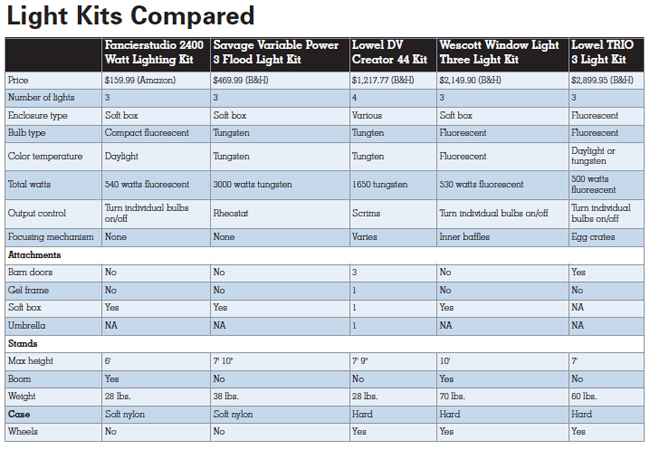Buyer's Guide: Light Kits
Next up is output control. All fluorescent systems control intensity by turning individual bulbs on and off, so your key light might have five bulbs blazing, and your fill light only three. The Savage system includes a rheostat for infinite control, though this may impact color temperature as well at lower power values. With some of the lights on the Lowel system you can use scrims to reduce lighting intensity, or of course move the light further from the subject if you have room.
As the name suggests, focusing mechanisms let you focus the intensity of the light. For example, the inner baffles on the Wescott system and particularly the egg crates on the Lowel lights enable a tightly-focused soft light that can add a touch of drama to a shoot, say by lighting only the head and shoulders of the subject. Many traditional tungsten lights, like some lights in the Lowel Kit, contain focus knobs that allow similar control. In contrast, the two systems on the left push out copious amounts of flat lighting that's impossible to focus.
Attachments also enhance your ability to control lighting. For example, barn doors let you precisely control the edges of your lighting. Since a solid frame is required for barn doors, this typically isn't an option on softboxes. Gels are a valuable tool for changing the color of your lighting, whether to match ambient lighting or create a specific effect, like yellowish lighting for warmth, or bluish for cold. The solid enclosures used on the Lowel system make it easy to attach frames that can hold the gels; with softboxes you'll have to jury rig your own technique for attaching gels, which often involves wooden clothpins.
Moving down the features table, stand height is an obvious concern for some producers, while a boom attachment allows you to extend the back light over the subject, a great convenience for keeping the stand out of the video. If your light kit doesn't include a boom stand, you should budget for one when buying or figure out how to attach the light to the ceiling or wall behind the subject.
Regarding the final item, cases, a hard body will always protect better than a soft base, and wheels are always a good thing, particularly when the kit weighs 60 pounds or more.
Other Lighting Considerations for Online Video
What else to consider? If you actually get to touch the kit before buying, check the construction of critical load bearing pieces. Many of the connectors and fasteners on inexpensive kits are made of plastic, and are one over-enthusiastic twist away from being worthless. Also assess the durability of the softbox, considering the strength of the materials, the soundness of the seams and the robustness of the rod/fabric connector. If you're looking for a truly portable systems, does it feel like it will last through twenty or thirty setups?
Also consider the stability of the light stands. Cheaper stands are lighter and less stable, and more subject to easily tipping over. The best stands are air-cushioned, so sections descend slowly if they get loose, protecting the lighting gear from a quick drop, and your fingers from a painful pinch. Cheaper stands use inner springs to cushion any drops, which aren't as effective and won't protect your fingers. Before buying any of this gear, check reviews on Amazon and B&H, particularly for the less expensive kits.
Finally, like everything else, when it comes to lighting, you get what you pay for. The least expensive kits will let you produce sufficient light to shoot with zero gain, and create shadowed and flat lighting, but will be time consuming to set up and tear down and likely won't withstand the rigors of portable use. They're great kits for novices and for basic use, but if you need portability and/or the ability to create truly dramatic lighting effects, you'll have to pay a lot more.
